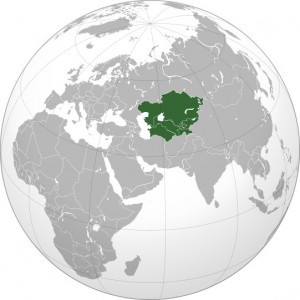BISHKEK (TCA) — Editor’s note: We are glad to publish an essay of a young Indian journalist, from the South Asian University of New Delhi. The essay shows how modern infrastructure is trying to resolve old problems in an integrated effort of several countries while requiring worldwide attention for a balanced and peaceful development of Central Asia, the “heartland” between Europe, Russia and China.
NEW DELHI (TCA) — In 1904, the British Geo-strategist Halford Mackinder (a founding father of the classical Geopolitical thinking) presented his phenomenal paper titled ‘The Geographical Pivot of History’, a geopolitical analysis of the Euro-Asian landmass. The topography of Eurasian steppe region as a landlocked, fertile and undulating terrain along with its geographical connectivity with Europe, Russia, China and South Asia, he accorded it a status of the most coveted landmass on earth. The smooth plains of the steppes, marked by inland river irrigation but absence of sea resulted in sustenance of populations without any threat of a maritime invasion and hence, due to the absence of sea that this region escaped colonial conquests till late 19th Century.
He termed this region as the ‘Pivot’ region, making it a core element of his ‘Heartland’ theory later. It was this analysis of Mackinder which introduced the supremacy of, and driven-mobility into global political discourse. Hence, there is a need to analyze the importance of the region’s geography, as well as the ‘mobility’ factor through a contemporary analysis, specifically the Central Asia-Caucasus region.
After the First World War, the Central Asia-Caucasus region went into a hibernation phase due to the Soviet control and the centralization of the affairs of all Soviet republics by Moscow. With the disintegration of USSR in 1991, the region breathed a new life and the legacy of Mackinder found expression in the combination of economic potential and geopolitics of energy. The herald of 21st century witnessed the nascent beginnings of the transformation of Central Asia’s regional integration through infrastructure corridors and pipelines promoted by different players in addition to Russia. Great interest has been shown by Europe and China and lately also by India.
The first development took place in 1992 when the idea of a pipeline connecting Central Asia to Europe was conceived proposing a pipeline project from the Caspian fields of Azerbaijan to Turkey which was completed by 2005. This pipeline, known as the Baku-Tbilisi-Ceyhan (BTC) pipeline, runs from Azerbaijan via Georgian Capital and ends at the Mediterranean port of Ceyhan in Turkey. From there the oil is transported to other European countries. Another parallel gas pipeline, the Baku-Tbilisi- Erzurum (BTE) or the South Caucasus pipeline has also been completed always to reduce Europe’s dependence on the monopoly of Soviet pipeline network. The fact that the World Bank and European Bank for Reconstruction and Development (EBRD) were the major financiers proves that the project was aimed at linking Central Asian region to Europe through the Geopolitics of energy. A further proposal to extend the pipeline westward is the Nabucco pipeline, which will extend the BTE gas pipeline to Austria.
But recently the greatest financial driving force behind any type of infrastructure has been China that has invested heavily in integrating the region. Beginning with the Trans Asian Pipeline which is a network of 1,800 kilometres long oil and gas pipelines coming from Central Asia, China has started a series of transnational highways and railroads to integrate the region aimed at securing its access to Europe. On 18 November 2014 a rail freight corridor connecting the city of Yiwu in the eastern part of China with Spain via Kazakhstan, Russia, Belarus, Poland, Germany, and France was inaugurated. The train reached destination on 8 December after only twenty days transporting 82 containers along 13,000 kilometres. With the New Silk Road Economic Belt program China is supposed to invest $40 billion, most of which will be directed to transcontinental infrastructure that will include Central Asia, but also South Asia, with particular attention to the new China-Pakistan economic corridor which will link Pakistan’s Gwadar Port to Xinjiang, which is China’s gateway province to Central Asia owing to its borders with Kazakhstan, Kyrgyzstan, and Tajikistan.
After China, India is joining in the infrastructural effort to contribute to the regional dynamics of Central Asia. The International North South Trade Corridor (INSTC) is a multimodal transport network which aims at reducing the trade distance between India and Central Asian nations. The route links India’s Mumbai port to the Iranian ports, which further connect St. Petersburg (Russia) via Turkmen territory through railway lines. Many feeder networks are proposed to be linked to this main route, which is expected to make inroads into Kazakhstan, Uzbekistan and Tajikistan. If the INSTC aims to link Central Asia along the north-south axis, TAPI project will bring natural gas from Turkmenistan to Afghanistan and India via Pakistan via a pipeline of 1,800 kilometres.
It is undoubted that Economy and Energy have been the driving factors behind the importance accorded to Central Asia, but in the background it is the positioning of this heartland region at the Crossroads of Europe and Asia which make it indispensable to them. Mackinder’s ideas, which were primarily meant to address the imperial interests of the British Empire, are being today developed for a sustainable economic linkages aimed at an efficient regional integration.
* Prateek Joshi is an Indian university student pursuing post graduation in International Relations (final year) from the South Asian University (a SAARC project), New Delhi. prat.josh2812@gmail.com



